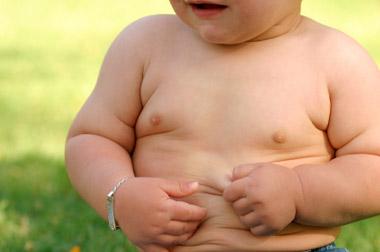Obese Toddlers and Infants course


After completing the session you will understand the usual causes of obesity in very young children, and it is hoped you will take away a range of strategies for helping families where obesity is a problem.
Learning objectives
By the end of this session you will be able to:
- Recognise obesity in infants and toddlers
- List the causes of obesity in this age group
- Assess infants and toddlers to determine if they are obese or overweight
- Recognise the effects of obesity in the short and long term
- Describe strategies for managing obesity in this age group
Obesity often begins in the baby and toddler age group. This can be a tricky concept for parents to comprehend - they may hold the belief that a healthy toddler/baby should be ‘chubby’. Obesity in pre-school children can also present a challenge for health professionals.
Before commencing this session you should complete the following AH sessions:
- 08_02 Infant Feeding Part 1: Breastfeeding (402-0042)
- 08_03 Infant Feeding Part 2: Formula Feeding (402-0008)
- 08_04 Infant Feeding Part 3: Introducing Solids (402-0044)
- 08_06 Healthy Eating For Toddlers: 1-4 Years (402-0045)
- 08_07 Weighing and Measuring Infants and Children (402-0046)
- 08_08 Growth Charts and their Interpretation (402-0047)
Dr Nichola Aspinall is a paediatric registrar currently working at the Leeds General Infirmary. During her career she has worked across Yorkshire and in London. Dr Aspinall has a wide range of experience in a variety of hospital paediatric settings. She also has a good background in primary care paediatrics, having worked both in community paediatrics and in General Practise. Her research interest is paediatric obesity. She has contributed to a national working party on obesity recognition in pre-schoolers and babies.

- Anaesthesia Fundamentals | Physiology | Ventilatio...
- Posted By eIntegrity Healthcare e-Learning
- Posted Date: 2024-12-26
- Location:Online
- This session describes how and why ventilation and perfusion vary in the healthy lung. Causes of hypoxia, such as hypoventilation, increased dead space and shunt, are discussed to help the trainee explain and manage hypoxia clinically.
- Anaesthesia Fundamentals | Physiology | Pulmonary ...
- Posted By eIntegrity Healthcare e-Learning
- Posted Date: 2024-12-26
- Location:Online
- This session covers the measurement and clinical importance of lung volumes, including functional residual capacity and dead space. Information regarding the performance and interpretation of flow-volume loops is also included.
- Anaesthesia Fundamentals | Physiology | Co2 Carria...
- Posted By eIntegrity Healthcare e-Learning
- Posted Date: 2024-12-26
- Location:Online
- This session covers the physiology of how carbon dioxide is carried by blood, including its conversion into bicarbonate ions and the role of the red blood cell and haemoglobin in this process. The session also describes how buffers work, and the fundament
- Anaesthesia Fundamentals | Physiology | Function o...
- Posted By eIntegrity Healthcare e-Learning
- Posted Date: 2024-12-26
- Location:Online
- This session focusses on the function of haemoglobin in oxygen (O2) carriage from the lungs to other tissues where cells are supplied with the O2 required for oxidative phosphorylation in the mitochondria. We will cover the structure
- Anaesthesia Fundamentals | Physiology | Gaseous Ex...
- Posted By eIntegrity Healthcare e-Learning
- Posted Date: 2024-12-26
- Location:Online
- This session will introduce you to the physiological effects of altitude and the adaptations that occur with acclimatization. It also introduces the pathology and physiology of high pressure and decompression.








